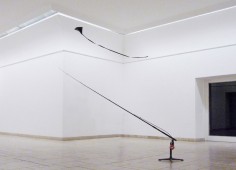Johannes Vogl
ЙОХАННЕС ФОГЛ

source: artnewsorg
“It seems that art, for Johannes Vogl, is a miraculous means to deal with a surrounding reality in a constant exceptional state of a raised intensity where senses are sharpened and perception becomes activated. As a careful observer of the everyday, Vogl is in a condition of a permanent alert with a volcanic (creative) energy and vigilance, bursting out at each step and reaction. Here, artistic field is an open and unlimited area of genuine possibilities and potentialities where endless solutions are being applied and new unexpected constructions are being staged on the crossway of inspiring reality and seductive fiction. Vogl is such a constructor and a passionate inventor of objects on the edge of functionality and fairy-tale like surreal application, beyond reason, within the realm of almighty imagination. »Watching the Waves«, 2005 is typical for Vogl attempt at creating an all-satisfactory and comfortable micro-environment with all necessary conditions for experiencing a particular phenomenon of nature. The artist is an author of self-sufficient structures, appearing as almost parasitic mechanisms that confuse the usual objecthood and functionality of things, bringing in certain competitive qualities too, as it might be a case of »Kleiner Mond«, 2006, a seductive and almost lyrical example of imitation and mimicry. Vogl’s is extremely sensitive poetics of the everyday gesture, non-pretentious, authentic supplement to a reality, turned for a moment into a playground where a moderate dose of irony and a good sense of humour balance the precariousness and insufficiency of today’s (imperfect) world.”
Adam Budak, 2006
.
.
.
.
.
.
.
source: jette-rudolphde
Johannes Vogl’s Objekte, Installationen, Videos und Fotografien vermitteln sich dem Betrachter als Gestalt gewordene Experimente an Natur und Wissenschaft sowie deren Wahrnehmung und Erfahrung ausgelöst durch persönliche Erinnerungen, Szenen des Alltags oder der menschlichen Sehnsucht nach Schönheit und Zufall.
Gebrauchsgegenstände des alltäglichen Bedarfs dienen dem Künstler als Motiv(ation) seiner mechanischen Apparaturen, wobei ihr Entstehungsprozess sichtbarer Bestandteil der Arbeit ist. Der performative Handlungsstrang kulminiert dabei nicht selten in der Visualisierung eines ästhetischen Ereignisses: ein Ensemble leerer Bierflaschen präsentiert sich als symmetrisches wie explosiv aufgeladenes Mobile, während ein brennender Müllkorb hochauf am Fahnenmast installiert am Meeresstrand als „Ghostlight“ Orientierungspunkt und Irrlicht zugleich ist.
Vogls mechanische Objekte bewegen sich „im Spannungsfeld von Funktionalität und Skulpturalität, von tatsächlicher Benutzbarkeit und Objekthaftigkeit“. Sie lösen Kettenreaktionen aus, erscheinen als symbolhafte Surrogate der Realität und funktionieren als humorvolle wie ambivalente Verweise des Künstlers auf eine triviale Lebenssituation und ihre auslösenden Momente kognitiver Wahrnehmung.
.
.
.
.
.
.
.
source: jette-rudolphde
Johannes Vogl´s objects, installations, videos and photographs are presented to the viewer as jelled experiments in nature, science and physics. Their perception and knowledge is derived from the artist´s personal memory, the scenery of the every day and the human longing for beauty and coincidence. The everyday objects of daily life inspire the artist’s machines, with their mechanics and engeneering processes as a visible part of the work. Alongside their performative strand they culminate in the visualization of an aesthetic event, e.g.: an ensemble of suspended empty beer bottles presents itself as a symmetric but explosively charged mobile (“Wolke”); a burning waste bin installed atop a flagpole on a beach, entitled „Ghostlight“, serves as control point and fen fire at the same time. Vogl´s mechanical objects circulate in the “area of tension between functionality and sculpture, between actual usability and object” (Elisabeth Konrath). They allow chain reactions to appear as symbolic surrogates of reality and humorously and ambivalently hint at superficial situations at the triggering moment of cognitive perception.
.
.
.
.
.
.
.
source: martinjandaat
1981 geboren in Kaufbeuren / born in Kaufbeuren (DE); 2002–2005 Studium an der Staatlichen Akademie der bildenden Künste Karlsruhe / Studies at the Academy of Fine Arts Karlsruhe (DE); 2005–2007 Studium an der Akademie der bildenden Künste Wien / Studies at the Academy of Fine Arts Vienna (AT)2007/2008 Studium an der Kunsthochschule Berlin-Weissensee, Berlin (DE) / Studies at the Berlin-Weissensee Kunsthochschule, Berlin (DE); 2008–2009 Studium an der Universität der Künste Berlin (UDK) / Studies at University of the Arts Berlin (DE); lebt und arbeitet in Berlin und Wien / lives and works in Berlin (DE) and in Vienna (AT).
.
.
.
.
.
.
.
source: oldsiteaptglobalorg
Johannes Vogl (b. 1981 in Kaufbeuren, Germany) studied at the University of Arts Berlin, the Berlin-Weissensee Kunsthochschule (?? Academy of Art, Berlin, White Lake??), the Academy of Fine Arts Vienna, and at the Academy of Fine Arts Karlsruhe. Recent solo exhibitions include Johannes Vogl-The Story Cellar at the Austrian Cultural Forum in London (2008); and Johannes Vogl at the Austrian Cultural Forum in Bratislava, Slovakia (208). He has also exhibited at the Manifesta 7 in Rovereto, Italy, the Sinop Bienale II in Turkey, and at the OK Center for Contemporary Art in Linz, Austria. He is represented by the Galerie Martin Janda in Austria. Johannes Vogl lives and works in Berlin and Vienna.

